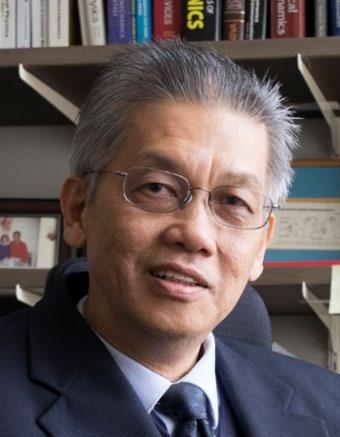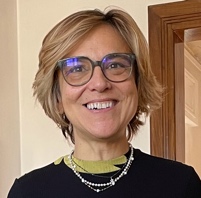Plenary Lecture 1
Evolution of Computational Electromagnetics, Review of the State of the Art and Future Prospects
Tuesday June 24, 2025
Dr. Ulrich Jakobus
Altair Engineering
Abstract – The talk will review the evolution of computational electromagnetics (CEM) over the last decades with particular emphasis on real world / industrial problems, present the state of the art and conclude with an outlook on the future.
Advances in computing technology – initially increasing CPU clock rates followed by an increase in the core count and high-performance computing (HPC) facilities with massively parallel clusters and the introduction of GPU computing – allow the numerical solution of CEM problems in fractions of the time that was required years or even decades ago. However, the demand from the user community to solve larger and increasingly complex electromagnetic problems has grown faster, necessitating other approaches like faster solvers (multilevel fast multipole method MLFMM, characteristic basis function method CBFM) or the combination of full wave solvers (MoM, finite element method FEM, finite difference time domain FDTD) with high frequency asymptotic methods (physical optics PO, ray-launching geometrical optics RL-GO, uniform theory of diffraction UTD) through bi-directional hybridization schemes.
These different frequency and time domain full wave methods, the asymptotic methods and their hybrid combination will be reviewed during the talk, looking both at the high-level formulations, but also showing their benefits and deficiencies from an application perspective considering real world industrial examples.
Specialized solutions complement these more general CEM techniques like cable harness or windscreen antenna modelling, fast array / radome solvers, characteristic mode analysis CMA to gain insight into the properties of radiating structures, special via solvers for SI/PI analysis of PCBs, or dedicated propagation modelling approaches for 5G / 6G networks.
Finally, and as future perspective, some approaches and examples will be discussed how AI / ML complement traditional CEM methods today and might in future open-up unprecedented possibilities to solve complex / multiscale problems in much shorter times on a laptop computer than what is possible today on massively parallel supercomputers.

Ulrich Jakobus graduated in electrical engineering from the University of Stuttgart, Germany. He completed his PhD and Habilitation and became Privatdozent at the same university. His areas of research included numerical techniques in electromagnetics, antennas, electromagnetic compatibility, and bio-electromagnetics, laying the foundations for the electromagnetics code Feko in 1991.
Since 2000 Dr. Jakobus has been Director of EM Software & Systems in Stellenbosch, South Africa, and in 2002 he also founded EM Software & Systems GmbH in Böblingen, Germany, focusing on the development and commercialisation of Feko. In 2014 he joined Altair through an acquisition, where he is currently acting as Chief Engineer – Electronics, overseeing all the electromagnetic and EDA product developments.
Dr. Jakobus has published extensively on computational electromagnetics and related topics. He received several awards for his research and leadership. He is a member of URSI commission B, the German VDE/ITG, Fellow of IEEE, and Fellow of ACES.
Plenary Lecture 2
Deriving Quantum EM Solutions Using Classical Knowledge—An Overview
Wednesday June 25, 2025
Prof. Weng Cho Chew
Purdue University, Indiana, USA
Abstract – In this presentation, we will discuss how solutions of quantum Maxwell’s equations can be simplified by deriving them from the classical solutions of Maxwell’s equations.
Classical Maxwell’s equations have been with us for over 160 years now. With it, we have developed a tremendous knowledge base whereupon electromagnetics technologies can develop. Classical electromagnetics, together with semiconductors, have been the main drivers of enabling modern technologies for almost a century. We can use this knowledge to further energize the growth of modern nanotechnologies. This will help drive down the cost of memory chips, expedite speeds of computers, and enable cheap wireless communications. These technologies have enabled the sharing of new knowledge around the world, spawn new industries where we use our brains instead of our brawns, and lifted hundreds of millions of people out of poverty, creating a more peaceful world.
Classical computational electromagnetics (CEM) has seen leaps and bounds progress since the 1960’s, shortly after the advent of the digital computer. As a result, this knowledge has transformed how classical electromagnetics engineering has been performed. Virtual prototyping using CEM is routine in many areas of technological development related to classical knowledge. In fact, simulation has taken over 90 percent of modern design process. After over 50 years of development, a healthy knowledge base has emerged that many practitioners in the field can rely on. Quantum computational electromagnetics, however, is much younger, and the corresponding knowledge base much thinner. It thus presages a knowledge base growth for quantum electromagnetics, which is an emerging field of growing importance. This knowledge base is instrumental for the growth and success of many quantum technologies including quantum computing, sensing, communications, encryption, imaging, and metrology.
By capitalizing on our past achievements in the classical arena, we can help propel the growth of quantum technologies due to their increasing demand and their promise for further growth. This can produce surprise new technologies in the areas of computers, networking, communications, and computing.

Professor Weng Cho Chew received all his degrees from MIT. His research interests are in wave physics, specializing in fast algorithms for multiple scattering imaging and computational electromagnetics in the last 30 years. His recent research interest is in combining quantum theory with electromagnetics, and differential geometry with computational electromagnetics.
Chew was elected Member of the National Academy of Engineering in 2013, “for contributions to large-scale computational electromagnetics of complex structures.” He is a Fellow of the Institute of Electrical and Electronics Engineers (IEEE) (1993), the Optical Society of America (2003), the Institute of Physics (2004), the Electromagnetics Academy (2007) and the Hong Kong Institution of Engineers (2009). Chew received the IEEE Electromagnetics Award in 2017, the Applied Computation Electromagnetics Society Award in Computational Electromagnetics in 2015, and the IEEE Antennas and Propagation Society Chen-To Tai Distinguished Educator Award in 2008, “for outstanding contributions to education in the fields of electromagnetic theory and computational electromagnetics.”
He also received the Sergei A. Schelkunoff Best Paper Award from IEEE Transactions on Antennas and Propagation (with Jun-Sheng Zhao) in 2001, the Campus Wide Excellence in Professional and Graduate Teaching Award from the University of Illinois Urbana-Champaign in 2001, and the IEEE Leon K. Kirchmayer Graduate Teaching Award in 2000, among other recognitions. He was among the few who won two IEEE Technical Fields Awards: Graduate Teaching, and Electromagnetics. Chew was named an ISI Highly Cited Researcher in 2001 and he is an honorary professor at Tsinghua University, China, honorary professor at National Taiwan University, Taipei, and was a distinguished visiting scholar at The University of Hong Kong.[62] He was recently awarded the Pioneer Award by SPWLA.
In addition, Chew has been keenly aware of many social issues in this world. Since he grew up in Malaysia, which is a third-world country, he is the co-chair (with A. Poddar and A. Apte) of the Committee on Promoting Equality (COPE) in the same IEEE Society.
Plenary Lecture 3
High-Accuracy Satellite Antenna Testing employing the Spherical Near-Field Measurement Technique
Thursday June 26, 2025
Dr. Olav Breinbjerg
ElMaReCo, Copenhagen, Denmark
Abstract – The spherical near-field antenna measurement technique is unique in combining a range of fundamental advantages that render it the most accurate technique for experimental characterization of antenna radiation – and it is employed globally for testing of wireless technology from miniscule hearing aid antennas to giant satellite antennas. In particular, the inherent high accuracy makes this the preferable measurement technique for testing of science mission satellite antenna systems with very stringent demands for the measurement uncertainty – and many technical-scientific developments are being pursued to improve it even further. This presentation will review the central components of the spherical near-field antenna measurement technique – the spherical vector wave expansion and the antenna scattering matrix leading to the spherical transmission formula – emphasizing the close and stringent relationship between the theoretical and practical aspects of this measurement technique. Also, the presentation will discuss recent and on-going research to further develop this measurement technique – including such developments as antenna diagnostics, derivative sampling, numerical uncertainty estimation, and correction for signal averaging with on-the-fly sampling. Finally, the presentation will overview several challenging antenna calibration and measurement projects in relation to satellite missions within the European Space Agency’s earth observation programme.

Olav Breinbjerg received the M.Sc. and Ph.D. degrees in electrical engineering from the Technical University of Denmark (DTU) in 1987 and 1992, respectively. He was on the Faculty of DTU’s Department of Electrical Engineering as Assistant Professor from 1991 to 1995, Associate Professor from 1995 to 2005, and Full Professor from 2006 to 2021. From 1997 to 2021 he was also Head of the Electromagnetic Systems Group and the DTU-ESA Spherical Near-Field Antenna Test Facility, and he founded the DTU Electromagnetic Test Centre. He resigned his position at DTU in 2021 and founded ElMaReCo for independent research consultancy. Olav Breinbjerg was a Visiting Scientist at Rome Laboratory in 1988, a Fulbright Research Scholar at the University of Texas at Austin in 1995, and a Visiting Professor at the University of Sienna in 2011 and 2022. His research is generally in applied electromagnetics – and particularly in antennas, antenna measurements, computational techniques, and scattering – for applications in wireless communication and sensing technologies. He is the author or co-author of more than 75 journal papers, 250 conference papers, and 250 technical reports. Dr. Breinbjerg was a recipient of a U.S. Fulbright Research Award in 1995, the 2001 AEG Elektron Foundation’s Award, the 2003 DTU Student Union’s Teacher of the Year Award, the 2013 and 2015 European School of Antennas Teacher of the Year Awards, the 2020 Hans Christian Ørsted Award, and the 2023 AMTA Distinguished Achievement Award. Dr. Breinbjerg is Fellow of AMTA, Fellow of IEEE, Knight of the Order of Dannebrog, and the 2024-2025 AMTA Distinguished Speaker.
Plenary Lecture 4
Frontiers in Bioelectromagnetic Research: Simulations, Experimental activity and Applications
Friday June 26, 2025
Prof. Micaela Liberti
Sapienza University of Rome, Italy
Abstract – Bioelectromagnetic research is at the intersection of engineering, physics, and life sciences, driving advancements in healthcare, communication, and safety standards. This talk will explore the latest frontiers in the field, focusing on the synergy between numerical simulations, experimental validation, and real-world applications. We will discuss innovative computational techniques for electromagnetic field interactions with biological tissues, state-of-the-art experimental methodologies, and emerging applications in biomedical applications and exposure assessment. By bridging theoretical and practical approaches, this presentation aims to provide insights into current challenges and future directions in bioelectromagnetic research.

Micaela Liberti, Ph.D., is an Associate Professor at Sapienza University of Rome in the Department of Information Engineering, Electronics, and Telecommunications. Her research focuses on health protection and biomedical applications of electromagnetic fields, including electrical and magnetic stimulation of the nervous system and electrochemotherapy. She has a particular interest in the interaction mechanisms between electromagnetic fields and biological systems, as well as in microdosimetry, exposure system design, and patient dosimetry.
Since 2004, she has been actively involved in the EBEA Bioelectromagnetic School “Alessandro Chiabrera” as both a lecturer and organizer. She has been a member of the Scientific Council of the European Bioelectromagnetics Association (EBEA) since 2008 and was elected President in 2019. In 2011, she served as General Chair of the 10th International EBEA Congress in Rome. From 2012 to 2016, she was the National Deputy Representative of COST Action TD1104, a European initiative focused on the development of electroporation-based technologies and treatments (EP4Bio2Med).
Since 2021, Dr. Liberti has been a member of the Scientific Expert Group for the International Commission on Non-Ionizing Radiation Protection (ICNIRP) and the Technical Advisory Committee of the International Union of Radio Science (URSI) Commission K. In 2022, she joined TC28 of the IEEE Microwave Theory and Techniques Society (MTT-S). She was elected President-Elect of the BioEM Society in June 2024.